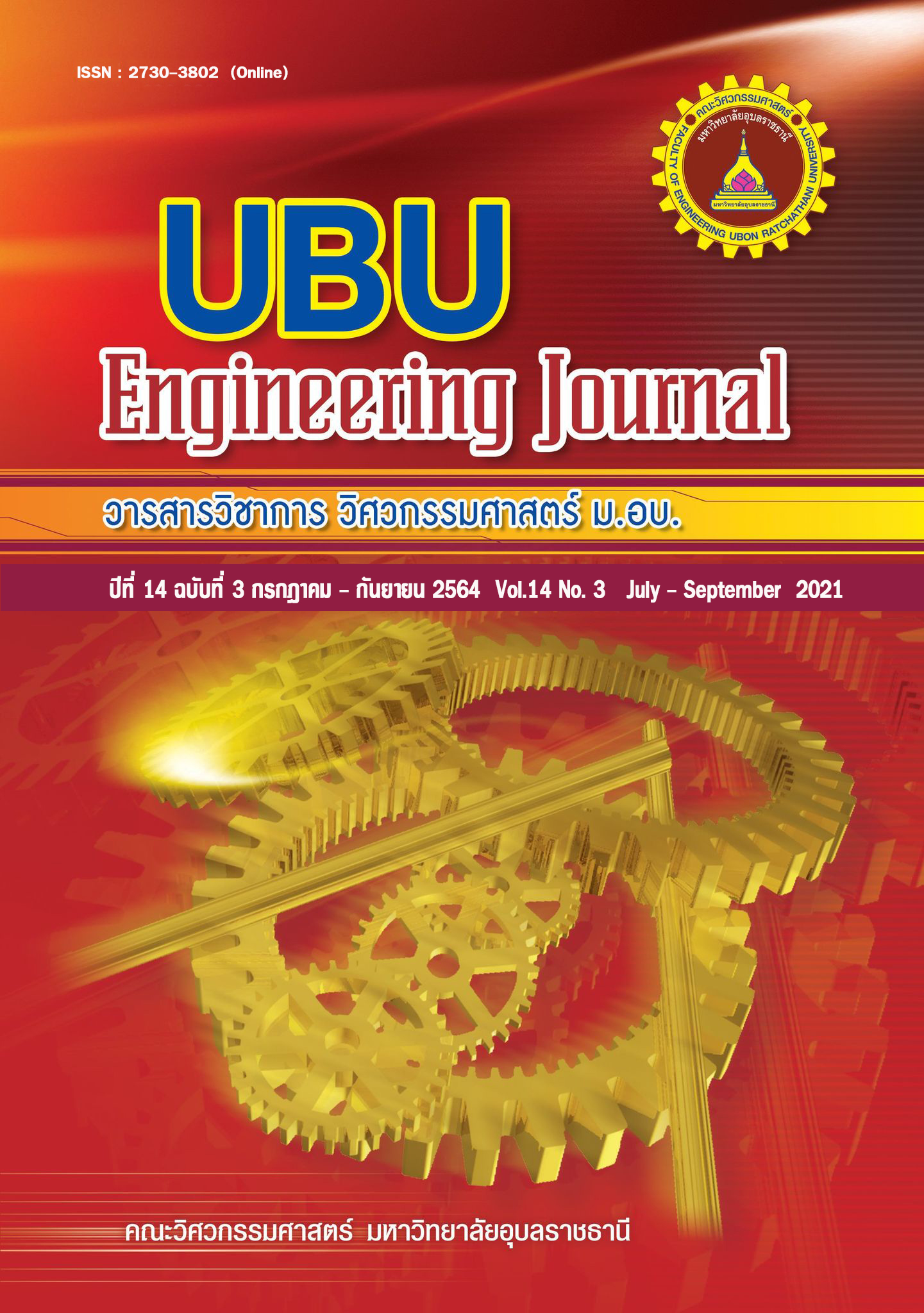Development of geopolymer concrete made from bagasse ash and calcined water supply sludge
Main Article Content
Abstract
This research aims to develop geopolymer concrete from waste materials. Bagasse ash from the sugar industry was used as source material. Since the bagasse ash (BA) contains a lot of silica but small amount of alumina. The calcined water supply sludge waste (WS) was compiled in the mixture to compensate the alumina. Bagasse ash and calcined water supply sludge were ground until their particle size retained on a standard sieve No. 325 less than 5% by weight. Bagasse ash was replaced by calcined water supply sludge in the rage of 5-7.5% by weight. The alkaline to binder materials ratio (AL/B) were between 0.50 -0.70. Two types of 3/8 inch coarse aggregates were used, crushed limestone and basalt. It was found that the effect of replacing bagasse ash with calcined water supply sludge resulted in a geopolymer concrete with compressive strength higher than 185-317 ksc. The higher AL/B ratio increases the workability of geopolymer concrete, but tended to affect the decreasing of compressive strength. Moreover, it was found that the coarse aggregate type had a significant effect on the compressive strength of the geopolymer.
Article Details
References
from http://www.oie.go.th
[2] สำเริง รักซ้อน และนิโรจน์ เงินพรหม การพัฒนา
วัสดุจีโอโพลิเมอร์จากเถ้าแกลบและเถ้าชานอ้อย
กรุงเทพมหานคร : สำนักงานคณะกรรมการวิจัยแห่งชาติ
[3] Abdulkadir Cevika, Radhwan Alzeebareea,
GhassanHumura, Anıl Niş, Mehmet ErenGülşan,
Effect of nano-silica on the chemical durability
and mechanical performance of fly ash based
geopolymer concrete, Ceramics International. 44
(2018) 12253-12264.
[4] สำเริง รักซ้อน วัสดุซีเมนต์ชนิดใหม่ มีเถ้าถ่านหิน
ผสมรวมกับเถ้าแกลบ- เปลือกไม้ วารสาร
วิศวกรรมศาสตร์ มหาวิทยาลัยขอนแก่น 2548; 32
(3):423-440
[5] Sata V. The Use of Local Pozzolan in Fiber
Reinforced Concrete Khon Kaen University
Engineering Journal 2010; 38 (1):29-37
[6] Guilherme Chagas Cordeiro, Pryscila Vinco
Andreao and Luís Marcelo Tavares. Pozzolanic
properties of ultrafine sugar cane bagasse ash
produced by controlled burning. Heliyon
October 1, 2019
[7] A. Rajasekar K. and et al. Durability characteristics
of Ultra High Strength Concrete with treated
Sugarcane bagasse ash. Construction and Building
Materials. Vol.171 20 May 2018, Pages 350-356
[8] A. Duangchan, “Development of Bagasse Ash
Concrete Block for Construction”. M.S. Thesis,
Dept. Civil Eingineering, Kasetsart University,
Thailand, 2006
[9] เกียรติสุดา สมนา การใช้ตะกอนประปาเป็นวัสดุประสาน
วารสารคอนกรีต สมาคมคอนกรีตแห่งประเทศไทย
[10] อนุชาติ ลี้อนันต์ศักดิ์ (2549) การศึกษาจีโอโพลิเมอร์จาก
เถ้าลอยและดินขาวเผา,วิทยานิพนธ์วิศวกรรมศาสตร
มหาบัณฑิต,มหาวิทยาลัยขอนแก่น จังหวัดขอนแก่น
[11] เจริญชัย ฤทธิรุทร (2550) การศึกษาจีโอโพลิเมอร์มอร์ตาร์
จากดินขาวระนองเผา,วิทยานิพนธ์วิศวกรรมศาสตร
มหาบัณฑิต,มหาวิทยาลัยขอนแก่น จังหวัดขอนแก่น
[12] อธิกา วงค์กวานกลม และ สหลาภ หอมวุฒิวงศ์ (2553)
การศึกษาจีโอโพลิเมอร์มอร์ต้าร์จากเถ้าชานอ้อยผสม
ตะกอนน้ำประปา ในการประชุมวิชาการวิศวกรรมโยธา
แห่งขาติ ครั้งที่ 15 วิศวกรรมโยธากับการพัฒนาท้องถิ่น.
วันที่ 12-14พฤษภาคม 2553, สุนีย์ แกรนคอนเวนชั่นเซ็น
เตอร์. อุบลราชธานี; หน้า 201.
[13] วรยศ วิฑูธีรศานต์, สหลาภ หอมวุฒิวงศ์, จักรพันธ์ วงษ์พา
(2556) การปรับปรุงตะกอนน้ำประปาด้วยวิธีการเผาผสม
เถ้าชานอ้อยเพื่อผลิตจีโอโพลิเมอร์มอร์ต้าร์ การประชุม
วิชาการวิศวกรรมโยธาแห่งชาติ ครั้งที่ 18. 8-10
พฤษภาคม 2556,เชียงใหม่ หน้า MAT 274-MAT 277
[14] กฤษดา นุ่มนวล (2540) การใช้ตะกอนจากระบบประปา
ทดแทนดินเหนียวในการผลิตอิฐมอญ วิทยานิพนธ์
วิศวกรรมศาสตรมหาบัณฑิตมหาวิทยาลัยเทคโนโลยี
มหานคร
[15] ปริญญา จินดาประเสริฐ และถนัดกิจ ชารีรัตน์ (2548)
โครงสร้างจุลภาคของจีโอโพลิเมอร์จากเถ้าลอยแม่เมาะใน
รายงานวิจัยศูนย์วิจัยและพัฒนาโครงสร้างมูลฐานอย่าง
ยั่งยืนขอนแก่นมหาวิทยาลัยขอนแก่น
[16] เธียรศักดิ์ กลับประสิทธิ์, ชัย จาตุรพิทักษ์กุล, ปริญญา
จินดาประเสริฐ และ สมิตร ส่งพิริยะกิจ วิศวกรรมสาร
ฉบับวิจัยและพัฒนา ปีที่ 19 ฉบับที่ 2 พ.ศ.2551 จีโอโพลิ
เมอร์เพสต์ที่ทำจากเถ้าถ่านหินและเถ้าชีวมวล ตอนที่ 1:
ของสัดส่วนผสมต่อกำลังอัด Fly Ash and Bio-mass Ash
Based Geopolymer Pastes Part I: Effect of Mix
Proportion on Compressive Strength
[17] Kong Daniel, L.Y., Sanjayan Jay, G., &KwesiSagoe-
Crentsil. (2007). Comparative performance of
geopolymers made with metakaolin and fly ash
after exposure to elevated temperatures.
Cement and Concrete Research, 37(12),
1583–1589.
[18] Abrams, D.A., “Design of Concrete Mixtures
Bulletin 1”, Structural Materials Research
Laboratory, Lewis Institute, Chicago, Revised
Edition, 1918, 20 pp.
[19] Zuhua, Z., Xiao, Y., Huajun, Z., & Yue, C. (2009).
Role of water in the synthesis of calcined kaolin-
based geopolymer. Applied Clay Science, 43(2),
218–223
[20] El-Alfi, E.A., A.M. Radwan, and M.H. Ali. 2004.
Physicomechanical properties of basalt bricks.
International Ceramic Review 53(3): 178–181.
[21] ดนุพล ตันนโยภาส (2553) แร่และหินพิมพ์ครั้งที่ 2 คณะ
วิศวกรรมศาสตร์ มหาวิทยาลัยสงขลานครินทร์, สงขลา
[22] สมพิศ ตันตวรนาท ประชุม คำพุฒ และกิตติพงษ์ สุวีโร
(2555) การเพิ่มประสิทธิภาพการเป็นฉนวนความร้อนและ
การรับกำลังของคอนกรีตบล็อกผสมน้ำยางธรรมชาติ:
กรณีผสมมวลรวมขนาดต่างกัน เอกสารประกอบการ
ประชุมวิชาการวิศวกรรมโยธา แห่งชาติ ครั้งที่ 17 โรงแรม
เซ็นทาราโฮเทลแอนด์คอนเวนชันเซ็นเตอร์, อุดรธานี
[23] พุทธิพงศ์ หะลีห์รัตนวัฒนา คุณสมบัติทางกายภาพและ
เชิงกลของมวลรวมหยาบที่มีขนาดต่างกัน Physical
and mechanical properties of coarse aggregates
with different sizes ภาควิชาวิศวกรรมโยธา คณะ
วิศวกรรมศาสตร์ จุฬาลงกรณ์มหาวิทยาลัย
